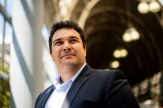Northeastern University wins $36M federal contract to build a system to protect schools, churches, and stadiums

It sounds like something out of a Bond movie: A packed sports stadium is under a bomb threat. A real-time surveillance system links key decision-makers inside and outside the building, allowing them to assess the situation and coordinate a response. The threat is neutralized before any harm is done.
There is a need to construct a versatile system designed to protect the vast array of so-called soft targets such as stadiums, schools, and places of worship. After an eight-month competition among the nation’s biggest universities, Northeastern was selected for a $36 million, ten-year contract to build it by the Department of Homeland Security, according to an announcement on Thursday.
Soft targets are usually civilian sites such as restaurants and train stations where large numbers of unarmed people gather, and could be vulnerable to an active shooter or some other type of attack. A hard target, by contrast, such as a military base, is usually heavily defended and not open to the public.
The acronym for the new DHS program that Northeastern will lead―SENTRY (Soft target Engineering to Neutralize the Threat RealitY)―gets to the heart of the system’s technology: A “Virtual Sentry” system that provides just-in-time information to key decision makers, such as the head of security at a big sports venue or the principal of an elementary school, to enable them to assess and thwart an attack.
“Protecting civilian soft targets and crowded spaces from covert threats is a complex and urgent challenge,” says Gregory D. Abowd, dean of Northeastern’s College of Engineering. “Northeastern has a longstanding history of success and innovation to improve the safety of our nation.”
The Virtual Sentry will integrate elements such as crowd-scanning sensors mounted atop light poles, video feeds, cell phone traffic, aerial drone footage, and social media posts.
That information will be sent to someone in charge―a school principal, for example―to decide what to do next.
“There has to be some level of human interface with the Virtual Sentry, otherwise it’s not going to work,” says Michael Silevitch, the Robert D. Black professor of engineering at Northeastern who led the winning team.
Eleven universities in total will be working on the project. In addition to Northeastern, they are: Rutgers, Boston University, Tufts University, the University of Southern California, SUNY Buffalo, the University of Puerto Rico-Mayaguez, the University of Rhode Island, Marquette, Rensselaer Polytechnic Institute, and Notre Dame.
Together they will comprise a new Center of Excellence for Engineering Secure Environments from Targeted Attacks, according to the DHS announcement.
The technology is focused solely on safeguarding civilian targets, but is similar to how the Pentagon sends information to team leaders to defend against a threat.
Work will take approximately a decade to complete given the system’s intricate hardware and software requirements. Companies such as defense contractor Raytheon and autonomous systems provider Draper will be part of an industrial advisory board for SENTRY.
Corporate business partners on the program could ultimately sell the technology to schools and churches, Silevitch says. But during the 10-year development stage it will be prototyped in a number of venues at no cost.
The system will be versatile enough to monitor soft targets of varying shapes and sizes, a strategic shift from older technologies that treated each target as a unique stand-alone location. “There’s such a wide variety of soft targets out there that if you try to focus on just one class, say schools, then that leaves out a whole set of other classes such as subway stations,” Silevitch says.
SENTRY should also handle various classes of threats as well, from a lone active shooter to a multi-pronged attack from a foreign power, he adds.
Key to Northeastern’s winning strategy was creating a multi-disciplinary research program driven by the long range goal of effectively protecting the vast array of soft targets.
“The four basic research thrusts were conceived at the outset to be part of an integrated whole, feeding off one another to solve these challenging problems,” says Carey Rappaport, an electrical and computer engineering professor at Northeastern who will serve as deputy director of SENTRY.
The program is part of DHS’s university-based network of Centers of Excellence. There are 10 centers nationally, each with a specific security focus. SENTRY will be funded through the department’s Office of University Programs.
Northeastern’s multi-disciplinary expertise significantly helped in winning the federal contract. For example, properly designing a school space, architecturally, to make it difficult for a threat to penetrate a soft target, involved interactions between architecture experts at the university’s College of Arts, Media and Design. “That was a very important element of our strategy,” says Silevitch.
“It is an honor and a major responsibility to lead the SENTRY effort to help protect our nation against incipient soft target attacks,” he adds.
For media inquiries, please contact media@northeastern.edu.




